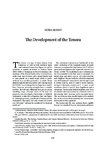The Development of the Tenora
| dc.contributor.author | Bonet, N | |
| dc.date.accessioned | 2021-07-06T17:38:23Z | |
| dc.date.available | 2021-07-06T17:38:23Z | |
| dc.date.issued | 2017-03 | |
| dc.identifier.issn | 0072-0127 | |
| dc.identifier.uri | http://hdl.handle.net/10026.1/17306 | |
| dc.description.abstract |
The tenora is a type of tenor shawm from Catalonia, an area in both northern Spain and southern France (see Figure 1), and its invention is usually attributed to Andreu Toron (1815–1886) of Perpignan in North Catalonia. Like members of the shawm family, it has ‘a conical bore, wider than that of oboes, and a broad double reed of cane placed on a metal staple which is partly enclosed in a wooden pirouette,’ to which Toron added a sophisticated key system and a flaring metal bell. While Toron’s design has six finger holes and 13 keys, however, surviving examples have a variable number. The bell and additional keys give it a large sounding range, although seven of the keys are played by only two fingers which make it a difficult instrument to play (for a fingering chart see Figure 2). Although generally considered a ‘traditional folk instrument’, the tenora has only existed for a little over 160 years, and may be considered ‘an invented tradition.’ | |
| dc.format.extent | 232-250 | |
| dc.language.iso | en | |
| dc.publisher | The Galpin Society | |
| dc.rights | Attribution-NonCommercial-NoDerivatives 4.0 International | |
| dc.rights | Attribution-NonCommercial-NoDerivatives 4.0 International | |
| dc.rights | Attribution-NonCommercial-NoDerivatives 4.0 International | |
| dc.rights | Attribution-NonCommercial-NoDerivatives 4.0 International | |
| dc.rights | Attribution-NonCommercial-NoDerivatives 4.0 International | |
| dc.rights | Attribution-NonCommercial-NoDerivatives 4.0 International | |
| dc.rights.uri | http://creativecommons.org/licenses/by-nc-nd/4.0/ | |
| dc.rights.uri | http://creativecommons.org/licenses/by-nc-nd/4.0/ | |
| dc.rights.uri | http://creativecommons.org/licenses/by-nc-nd/4.0/ | |
| dc.rights.uri | http://creativecommons.org/licenses/by-nc-nd/4.0/ | |
| dc.rights.uri | http://creativecommons.org/licenses/by-nc-nd/4.0/ | |
| dc.rights.uri | http://creativecommons.org/licenses/by-nc-nd/4.0/ | |
| dc.title | The Development of the Tenora | |
| dc.type | journal-article | |
| plymouth.author-url | http://www.nuriabo.net/index.php/research/ | |
| plymouth.volume | 70 | |
| plymouth.journal | The Galpin Society Journal: for the study of musical instruments | |
| plymouth.organisational-group | /Plymouth | |
| plymouth.organisational-group | /Plymouth/Faculty of Arts, Humanities and Business | |
| plymouth.organisational-group | /Plymouth/Faculty of Arts, Humanities and Business/School of Society and Culture | |
| plymouth.organisational-group | /Plymouth/Users by role | |
| plymouth.organisational-group | /Plymouth/Users by role/Academics | |
| dcterms.dateAccepted | 2016-04-10 | |
| dc.rights.embargodate | 2022-3-4 | |
| dc.rights.embargoperiod | Not known | |
| rioxxterms.licenseref.uri | http://creativecommons.org/licenses/by-nc-nd/4.0/ | |
| rioxxterms.licenseref.startdate | 2017-03 | |
| rioxxterms.type | Journal Article/Review |



